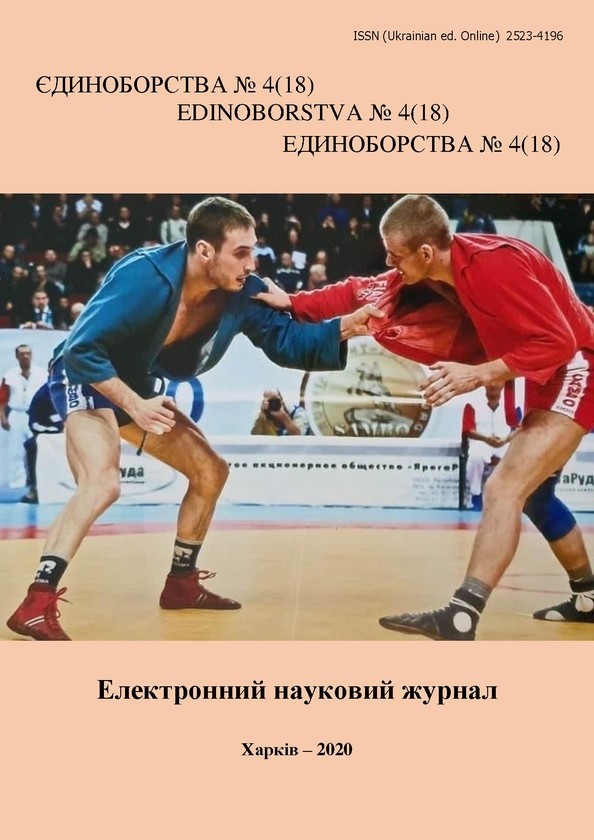The author's athlete training program at the stage of specialized basic training in pancration
DOI:
https://doi.org/10.15391/ed.2020-4.05Keywords:
structure, content, participation, training, programAbstract
Purpose: to develop the structure and content of the author's training program for athletes at the stage of specialized basic preparation in pankration in the annual training cycle (on the example of the second year of study, 15–16 years). Material and methods. The study used the following methods: theoretical analysis and generalization of literature sources, surveys of trainers-teachers of pankration, analysis of documentary materials. Results: there were carried out the generalization of scientific and methodical data and defined the bases for correction of qualified sportsmen preparation system in mixed combat sports on the basis of modern tendencies. The generalizations of theoretical data were supplemented by the results of the study normative documents on the training of athletes of different stages of long-term improvement in pankration; the results of the analysis indicators of athletes’ competitive activity at the stage of specialized basic preparation in pankration and generalization of practical experience on the basis of coaches’ interview, who working with the specified contingent of athletes. Conclusions. Significant author's differentiate regarding the existing structure and content of the program of annual training of athletes at the stage of specialized basic training in pankration are as follows: selection of exercises taking into account the specifics of competitive activities by athletes; taking into account the projected level of preparedness contained in the approach to the performance of adult athletes; differentiation of means of training taking into account variability of manners of conducting competitive activity and construction of technical and tactical actions; change in the ratio of the volume of exercises for general and special physical training; increasing the overall intensity of exercise. It is proposed to reduce the volumes by sections of theoretical training, technical training (selective influence), tactical training (selective influence), drawing up control standards, general and special physical training (selective influence), free and control fights. It is proposed to increase the volume of joint training with athletes of other sports teams, the number of staged fights, other sports; to supplement the structure with a section using the means of combined action of technical and tactical training and for physical training - by means of combined action with technical and tactical training; using sports related to the structure and content of competitive activities with pankration and specified the ratio of hours between participation in qualifying competitions and in refereeing and coaching practice.
References
Білецький, С. В. & Пономарьов, В. О. (2017). Теоретико-методологічні напрямки перекваліфікації спортсменів борцівських стилів на рукопашний бій. Єдиноборства, №2 (4), 7–10.
Вовк, В. В. (2008). Азбука панкратиона (Синтез борьбы и кулачного боя). Метод. пособие, Львов.
Гаранин, Е. А. (2015). Теоретические и практические аспекты моделирования соревновательной деятельности по армейскому рукопашному бою. Педагогико-психологические и медико-биологические проблемы физической культуры и спорта, № 4 (37), 47–56.
Гаранин, Е. А. & Кузнецов, С. А. (2015). Экспериментальная методика подготовки бойцов армейского рукопашного боя на основе учета индивидуального стиля ведения спортивного поединка. Физическая культура, спорт - наука и практика, № 4, 5–12.
Дзорданидис, В. & Кузьмин, В. В. (2008). Анализ соревновательной деятельности панкратионистов. Ученые записки, № 8(42), 28–31.
Коньков, Д. А. (2008). Методические особенности построения тренировочного процесса в панкратионе. Известия Российского государственного педагогического университета им. А.И. Герцена, № 58, 399–405.
Лю Юн Цянь. (2015). Вариативность физической подготовки дзюдоистов на этапе углубленной специализации. Физическая культура, спорт - наука и практика, № 4, 13–9.
Наконечний, І. (2020). Взаємозв’язок спеціальної фізичної та техніко-тактичної підготовки висококваліфікованих спортсменів з панкратіону. Вісник Прикарпатського університету. Серія: Фізична культура, 62–67.
Наконечний, І. Ю. (2017). Взаємозв’язок спеціальної фізичної підготовки та психологічного супроводу в багаторічній підготовці висококваліфікованих спортсменів з панкратіону. Молодий вчений, № 3.1 (43.1), 221–226.
Панкратіон (2010) : навч. програма для дитячо-юнацьких спортивних шкіл. Київ.
Платонов, В. Н. (1997). Общая теория подготовки спортсменов в олимпийском спорте. Олимпийский спорт, Киев.
Скрипка, І. М. & Чередніченко, С. В. (2018). Результати впровадження програми з загально та спеціальної фізичної підготовки з елементами панкратіону в процес фізичного виховання учнів молодших класів. Єдиноборства, №4(10), 52–61. DOI:10.5281/zenodo.1473625
Согор, О. & Пітин, М. (2018). Показники змагальної діяльності кваліфікованих дорослих спортсменів із панкратіону. Фізична активність, здоров'я і спорт, №2 (32), 36–43.
Согор, О. & Пітин, М. (2019). Показники змагальної діяльності юних спортсменів із панкратіону. Науковий часопис НПУ ім. М. П. Драгоманова, №9 (117), 83–89.
Согор, О., Пітин, М., Окопний, А. & Свістельник, І. (2017). Структура та зміст підготовки спортсменів на етапі спеціалізованої базової підготовки в панкратіоні. Фізична культура, спорт та здоров’я нації, 3 (22). 409−16.
Юхно, Ю. А., Зарудний, В. Ю., Олексенко, І. Н. & Журавель, А. В. (2011). Состав и структура соревновательной деятельности в панкратионе на современном этапе его развития. Физическое воспитания студентов, 4, 92–5.
Andreasson, J. & Johansson, T. (2018). Negotiating violence: mixed martial arts as a spectacle and sport. Sport in Society: Cultures, Media, Politics, Commerce, 1-15 https://doi.org/10.1080/17430437.2018.1505868.
Pityn, M., Okopnyy, A., Tyravska, O., Hutsul, N. & Ilnytsky, I. (2017). Dynamic of indexes of technical and tactical actions of qualified kickboxer individual fighting style. Journal of Physical Education and Sport, 17 (Supplement issue 3), 1024–1030. doi:10.7752.jpes.2017.s3157.
Radchenko, Y. A. (2015). Specific features of competition functioning of martial arts elite sportsmen. Pedagogics, Psychology, Medical-Biological Problems of Physical Training and Sports, 19 (12), 91–95. https://doi.org/10.15561/18189172.2015.12014.
Stenius, M. (2014). The Legacy of Pankration: Mixed Martial Arts and the Posthuman Revival of a Fighting Culture. Journal of Combat Martial Arts and Science, 14 : 4-27.
Zbigniew, B., Mircea, V. & Dariusz, G. (2014). The hierarchy of professional activities of martial arts and mixed martial arts coaches. Ido Movement for Culture. Journal of Martial Arts Anthropology, 14 (2), 29-35. DOI: 10.14589/ido.14.2.41.













